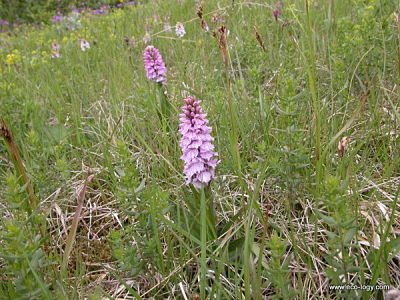BOTANY NEWS
Welcome to this seventeenth edition of Botany News!
TOPICS:
1. A note from the editor
2. Plants living in hot deserts
3. Northern trees: Poplars
5. A special announcement to Icelandic readers
6. The flower box
A note from the editor
A warm welcome to Botany News. This year our ecological consulting company, Thund, celebrates a ten year anniversary! You can follow our web updates on Eco-logy.com, bringing you up to date on our summer tours, Botanical Tours in Iceland. This winter is the perfect time to enjoy the trees, shrubs, and evergreen plants in your area. Also, pay attention to mosses and lichens on rocks and tree trunks. It is a good time to join a botanical, environmental, or other outdoor clubs. An increasing number of visitors come to Iceland in the wintertime to enjoy our winter wonderland, such as the northern lights displays, the colourful Christmas lights, and New Year celebration fireworks, as well as our snowy and windy weather! Always, come well prepared to Iceland, and ask for local guidance before you travel. Make sure you sign up for Botany News and share our web with your friends. Enjoy the months ahead and reading Botany News!
Plants living in hot deserts
Deserts are found all over the world, but many hot deserts are located in subtropical areas. The driest deserts are barren sands, while plants grow where there is any water. Xerophytes tolerate drought well, acquiring and preserving water. While many ephemerals produce seeds that remain dormant until the next heavy rains. When the rains fall the seeds germinate fast, grow and mature in the short growing season, at times changing the desert into beautiful flower fields. Many desert plants have shallow roots capturing the small amount of rain before the water penetrates deeper into the soil. Other plants, such as the Honey Mesquite (Prosopis glandulosa), a leguminous shrub found in both arid and semi-arid environments in North America, have long tap roots.
In the hot subtropical deserts of south-western United States and northern Mexico you typically find the small-leaved Creosote Bush (Larrea divaricata). Like many desert plants, the Creosote Bush tolerates the desert heat and drought, and escapes most herbivores by being very unpalatable. In the desert you frequently find the Creosote Bush growing in mixed shrubbery of woody plants, succulents, and ephemerals. The fine Whitethorn Acacia (Acacia constrictor) is a leguminous shrub found on very arid lands. In deserts with a less arid climate you find Yucca plants such as the robust Joshua Tree (Yucca brevifolia) and splendid Spanish Dagger (Yucca carnerosana).
Succulents, such as cacti, have chunky bodies that store water. They are coated with wax that stops water loss. Sharp spines on cacti prevent thirsty animals from reaching the plant’s juicy centre. Columnar cacti (Carnegiea spp.), such as enormous Saguaro (Carnegiea gigante), grow in many North American badlands, where you also find numerous cacti, for example, the yellow-flowered Texas Prickly Pear (Opuntia engelmannii).
The red flowers of the cactus-like Ocotillo (Fouquieria splendens) attract pollinating bees and hummingbirds. While, the rosettes of the agaves such as the Mescal (Agave derserti) and the Lechugilla (Agave lechuguilla) channel any air moisture toward their roots.
The desert plants of the south-western United States and northern Mexico are triggered by the summer rains. Among the wild plants are the gray-green leaved Cowpen Daisy (Verbescina encelioides), the pretty pink-flowered Desert Verbena (Verbena wrightii) and fragrant yellow-flowered Longspur Columbine (Aquilegia longissima).
Large and small desert plants provide shelter and food for animals and sometimes improve the condititions for neighbouring plants. At other times competition between plants for available water resources is fierce. While the plants are equipped with special structures to protect them from the sun and burning heat, most desert animals seek refuge during the daytime. While you may endure the scorching desert sun, the best time in the desert is often after sunset in the cool night air with the singing choir of insects!
Northern trees: Poplars
Two species of poplars, the European Aspen (Populus tremula) and Black cottonwood (Populus trichocarpa), are common poplars in the Northern Hemisphere. Both species have light grey and smooth young stems, while the trunk of older trees is darker and more fissured. Black Cottonwood is typically larger than European Aspen and has narrower leaves.
The European Aspen grows all over Europe, is widespread across Asia, and even occurs in North Africa. European Aspen is distributed throughout Britain in different types of woodland. It is particularly common in the Scottish Highlands and Islands where it occurs in diverse habitat ranging from sea cliffs up to upper forest limits. Similarly, European Aspen is common in Scandinavia, from southern Norway to northern Lapland. This species most often grows in mixed stands in Scandinavia, but in dense stands of its own in southern Norway. European Aspen is very rare here in Iceland, it occurs in the wild in Icelandic woodlands and heaths and is considered a native woody plant in Iceland. It is a small tree or shrub here, and has the distinctive broad, round-shaped leaves.
Black Cottonwood is native to the west coast of North America, where it often grown in damp riparian habitats and may reach up to two hundred years. Black Cottonwood is an introduced tree here in Iceland and has been planted all over the country. This tree is quite common in South West Iceland as a component of shelter belts on traffic islands, surrounding agricultural lands, and is quite common in Reykjavik city. Black Cottonwood grows well here forming strong erect trees, with long often upright branches. It produces massive amounts of pollen in the spring and early summer. Black Cottonwood is very popular in tree plantations in Iceland.
This time of year, the winter sun warms the leafless poplars that are favourite places for overwintering passerine birds, such as groups of Starlings (Sturnus vulgaris) and the occasional Redwing (Turdus iliacus).
A special announcement to Icelandic readers: - Tilkynning!
Sendið okkur bréf og greinar um gróður til birtingar í næsta hefti Gróðurfrétta (Botany News), þið getið líka skoðað eldri hefti á netinu. Mögulegt er að hafa tengla á ykkar vefsíður í fréttabréfinu. Tenglasíðan hjá Eco-Logy.com býður upp á innlenda og erlenda tengla. Hafið endilega samband ef þið viljið auglýsa á tenglasíðunni. Tenglarnir eru tengdir líffræði og vistfræði, vistvænni og heilsutengdri ferðaþjónustu, innlendri menningu og listum, og grænum lífsstíl. Sendið okkur endilega ábendingar um efni í næsta fréttarit.
The flower box
Botany News welcomes communications from folks working on all areas of botany and ecology. In particular, Botany News welcomes contributions from people working for the environment, biodiversity and conservation around the world. Please, feel free to suggest new links to interesting botanical web pages. All suggestions for improving the newsletter and the Eco-Logy.com website are welcome. We can see from our web analysis that our readers come from all parts of the world, let us know what botanical issues should be covered from your part of the world!
As before you can send in your own Botany News items. Short essays on botany, biology and conservation are especially popular. Or send us a review on recent developments in your area of interest and upcoming botanical events. The articles need be no longer than 150-300 words. However, articles that do not fit the profile and purpose of Botany News are not published. Once published your article is still yours and you keep the full copyright. Submit your Botany News article!
-----------------------------------------------------------------
Best wishes,
BOTANY NEWS is published by Thund, Reykjavik, Iceland
November 15, 2013 -- Botany News, Issue #017



Fáðu nýjustu fréttir og tilboð frá Þund!
Get updates and special offers from Thund!










